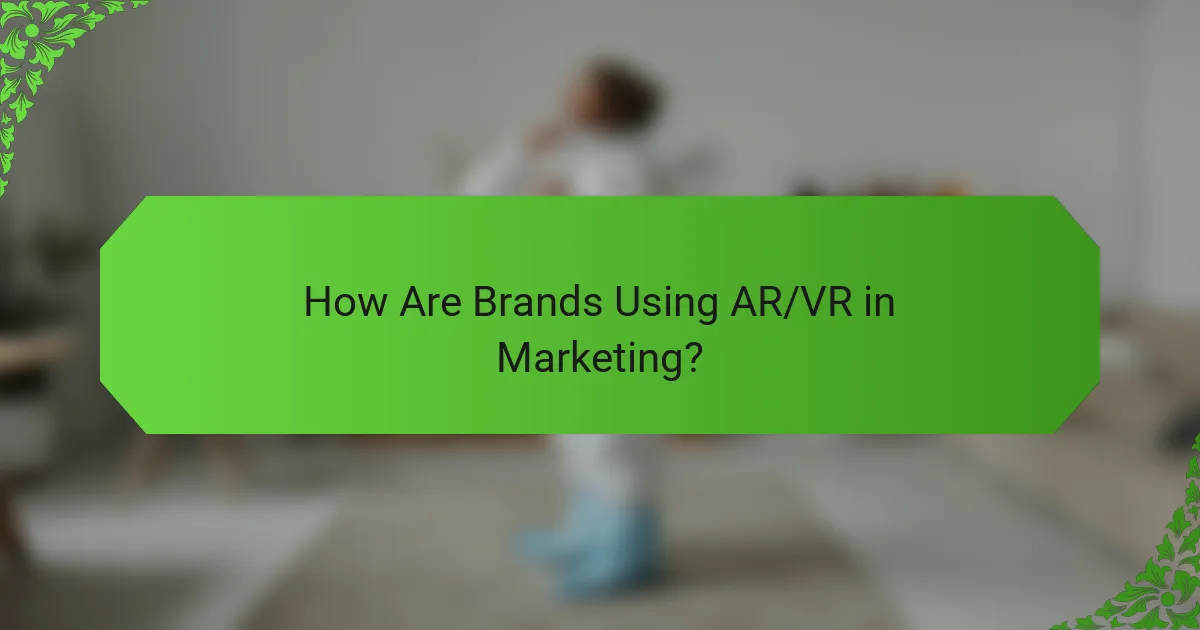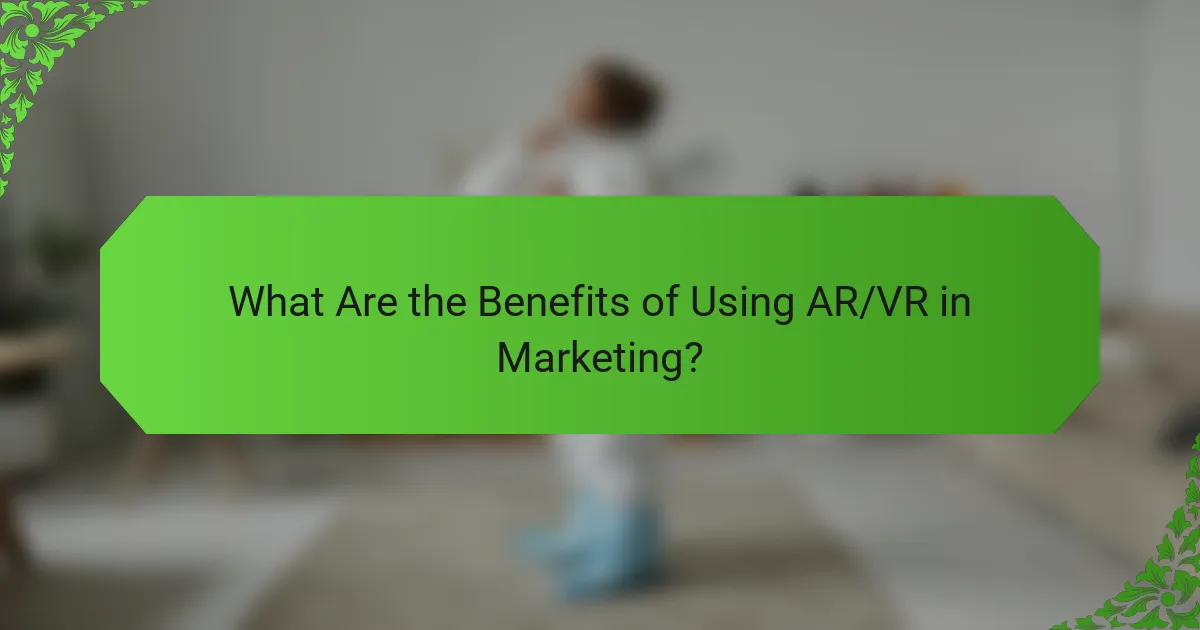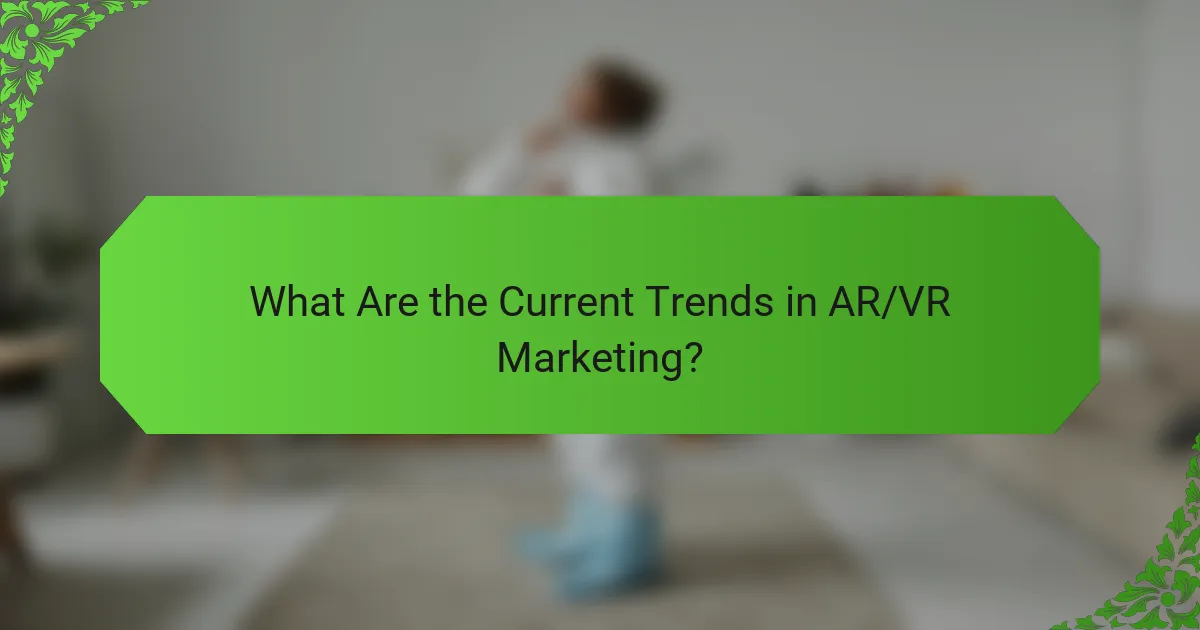As brands seek to captivate consumers in an increasingly competitive landscape, AR and VR creative tools are emerging as essential components of innovative marketing strategies. These technologies enable the creation of immersive experiences that enhance customer engagement and brand visibility, allowing marketers to connect with their audience in unique and interactive ways. By leveraging these tools, companies can significantly boost conversion rates and foster deeper relationships with their customers.

What Are the Key AR/VR Creative Tools for Marketing?
Key AR/VR creative tools for marketing include software that enables brands to create immersive experiences. These tools allow marketers to engage customers in innovative ways, enhancing brand visibility and interaction.
Adobe Aero
Adobe Aero is a user-friendly tool designed for creating augmented reality experiences without extensive coding knowledge. It allows marketers to design interactive 3D content that can be easily shared across platforms.
With Aero, users can import assets from other Adobe products like Photoshop and Illustrator, making it ideal for those already familiar with Adobe’s ecosystem. This integration streamlines the creative process, enabling quick iterations and adjustments.
Unity
Unity is a powerful game development platform that also excels in creating AR and VR experiences. It offers extensive features for building interactive environments, making it suitable for complex marketing campaigns.
Marketers can leverage Unity’s vast asset store and community resources to enhance their projects. However, it requires a steeper learning curve compared to simpler tools, so investing time in tutorials and practice is essential.
Blender
Blender is a free, open-source 3D modeling tool that is increasingly popular for creating AR and VR content. It provides a comprehensive suite of features for modeling, animation, and rendering, allowing for high-quality visuals.
While Blender has a robust set of capabilities, it may be overwhelming for beginners. Users should consider starting with basic tutorials to build their skills before tackling more complex projects.
Sketchfab
Sketchfab is an online platform that allows users to publish, share, and discover 3D content. It supports AR and VR viewing, making it a great tool for marketers looking to showcase products interactively.
With its easy-to-use interface, marketers can upload 3D models and create immersive experiences quickly. Sketchfab also offers analytics tools to track engagement, helping brands refine their strategies based on user interactions.
Snapchat Lens Studio
Snapchat Lens Studio is a creative tool for designing augmented reality experiences specifically for Snapchat. It enables marketers to create engaging lenses that users can interact with, enhancing brand visibility on social media.
Marketers should focus on creating fun and shareable content, as lenses that resonate with users tend to go viral. Familiarizing oneself with Snapchat’s guidelines and best practices is crucial for maximizing the impact of campaigns.

How Are Brands Using AR/VR in Marketing?
Brands are increasingly leveraging AR and VR technologies to enhance their marketing strategies, creating engaging experiences that captivate consumers. These tools enable interactive and immersive campaigns that can significantly boost customer engagement and conversion rates.
Interactive Product Demos
Interactive product demos allow consumers to experience products in a virtual environment, making it easier for them to understand features and benefits. Brands can create 3D models that users can manipulate, providing a hands-on experience without the need for physical samples.
For instance, automotive companies often use AR to let potential buyers explore vehicle interiors and features from their homes. This approach can shorten the decision-making process and increase the likelihood of purchase.
Virtual Try-Ons
Virtual try-ons enable customers to visualize how products like clothing, accessories, or makeup will look on them before making a purchase. This technology uses AR to overlay products onto a user’s image, enhancing the shopping experience and reducing return rates.
Fashion retailers, for example, have adopted virtual fitting rooms that allow shoppers to see how different outfits fit their body type. This not only improves customer satisfaction but also encourages more confident buying decisions.
Immersive Storytelling
Immersive storytelling uses AR and VR to create narratives that engage consumers on a deeper level. By placing users in the center of a story, brands can evoke emotions and foster a stronger connection with their audience.
For example, a travel company might use VR to transport potential customers to exotic destinations, showcasing experiences in a way that traditional advertising cannot. This method can significantly enhance brand recall and influence purchasing behavior.

What Are the Benefits of Using AR/VR in Marketing?
AR and VR technologies offer significant advantages in marketing by creating immersive experiences that captivate consumers. These tools enhance how brands interact with their audience, leading to more effective communication and engagement.
Enhanced Customer Engagement
Using AR and VR in marketing allows brands to create interactive experiences that draw customers in. For example, virtual try-ons for clothing or makeup can significantly increase user interaction, allowing customers to visualize products in a realistic setting before making a purchase.
Engagement can also be boosted through gamified experiences, where users participate in challenges or games related to the brand. This not only entertains but also fosters a deeper connection with the brand, encouraging loyalty and repeat visits.
Increased Brand Awareness
AR and VR campaigns can generate buzz and attract attention, making them effective tools for increasing brand visibility. Unique experiences, such as a virtual tour of a product’s features or an immersive storytelling campaign, can stand out in crowded markets.
Brands that leverage these technologies often see a rise in social media shares and discussions, amplifying their reach. For instance, a well-executed AR campaign can lead to viral moments, significantly enhancing brand recognition among target audiences.
Improved Conversion Rates
Implementing AR and VR can lead to higher conversion rates by providing customers with a clearer understanding of products. When consumers can visualize how a product fits into their lives, they are more likely to make a purchase. Studies suggest that immersive experiences can increase purchase intent by a substantial margin.
To maximize conversion rates, brands should ensure that their AR/VR experiences are user-friendly and accessible across devices. Offering seamless integration with e-commerce platforms can facilitate immediate purchases, turning engagement into sales effectively.

What Are the Current Trends in AR/VR Marketing?
Current trends in AR/VR marketing focus on enhancing user engagement through immersive experiences, personalization, and data-driven strategies. Brands are increasingly leveraging these technologies to create memorable interactions that resonate with their target audiences.
Personalization
Personalization in AR/VR marketing allows brands to tailor experiences to individual preferences, enhancing user engagement. By utilizing data on user behavior and preferences, companies can create customized content that speaks directly to their audience’s interests.
For example, a cosmetics brand might use AR to let users virtually try on makeup shades that match their skin tone, increasing the likelihood of purchase. This level of personalization can lead to higher conversion rates and improved customer satisfaction.
Social Media Integration
Integrating AR/VR experiences with social media platforms is becoming essential for brands looking to expand their reach. Users can share their immersive experiences directly on platforms like Instagram or Snapchat, amplifying brand visibility and engagement.
Brands can create AR filters or VR experiences that encourage users to interact and share, creating a viral effect. This strategy not only promotes user-generated content but also fosters community engagement around the brand.
Data-Driven Experiences
Data-driven experiences in AR/VR marketing rely on analytics to inform content creation and user interactions. By analyzing user data, brands can optimize their AR/VR offerings to better meet consumer needs and preferences.
For instance, tracking how users interact with an AR app can reveal which features are most engaging, allowing brands to refine their strategies. This approach ensures that marketing efforts are not only innovative but also effective in driving results.

What Should Brands Consider When Choosing AR/VR Tools?
Brands should evaluate several key factors when selecting AR/VR tools, including their target audience, budget constraints, and technical requirements. These considerations will help ensure that the chosen tools align with marketing goals and deliver effective user experiences.
Target Audience
Understanding the target audience is crucial for selecting the right AR/VR tools. Brands should analyze demographics, preferences, and behaviors to determine which technologies will resonate most effectively. For instance, younger audiences may prefer immersive experiences, while older demographics might favor simpler, more accessible applications.
Conducting surveys or focus groups can provide insights into audience expectations and help tailor AR/VR experiences accordingly. This alignment can significantly enhance engagement and conversion rates.
Budget Constraints
Budget is a significant factor when choosing AR/VR tools, as costs can vary widely based on technology and complexity. Brands should establish a clear budget range that includes not only the initial investment but also ongoing maintenance and updates. Typical costs can range from a few thousand to several hundred thousand dollars, depending on the project scope.
Prioritizing features that deliver the highest return on investment can help brands make informed decisions. It’s often beneficial to start with a pilot project to test the waters before committing to larger expenditures.
Technical Requirements
Technical requirements play a vital role in the successful implementation of AR/VR tools. Brands must assess their existing infrastructure and ensure compatibility with the chosen technologies. This includes evaluating hardware capabilities, software requirements, and network bandwidth to support seamless experiences.
Additionally, brands should consider the skills of their team. If in-house expertise is lacking, investing in training or hiring specialists may be necessary. Keeping abreast of industry standards and emerging technologies can also help brands remain competitive in the evolving AR/VR landscape.

How to Measure the Success of AR/VR Marketing Campaigns?
Measuring the success of AR/VR marketing campaigns involves analyzing various metrics that reflect user engagement and conversion rates. Key performance indicators (KPIs) such as user retention, interaction time, and sales conversions provide insights into the effectiveness of these immersive experiences.
Key Performance Indicators (KPIs)
To effectively measure AR/VR campaign success, focus on specific KPIs. Common metrics include user engagement rates, which reflect how long users interact with the content, and conversion rates, indicating how many users take desired actions, such as making a purchase or signing up for a newsletter.
Additionally, consider tracking customer feedback and satisfaction scores. Surveys and reviews can provide qualitative insights that complement quantitative data, helping to refine future campaigns.
Tools for Measurement
Utilize analytics tools designed for AR/VR environments to gather data. Platforms like Google Analytics can be adapted for AR/VR experiences, while specialized tools such as Unity Analytics offer in-depth insights tailored to immersive content.
Implementing heatmaps can also help visualize user interactions within AR/VR experiences, revealing which elements attract the most attention and engagement.
Common Pitfalls to Avoid
One common pitfall is relying solely on vanity metrics, such as total downloads or views, without assessing deeper engagement metrics. Focus on actionable data that reflects user behavior and satisfaction.
Another mistake is neglecting to set clear objectives before launching a campaign. Define what success looks like upfront to ensure that measurement efforts align with your marketing goals.